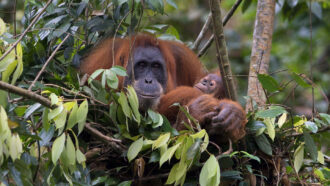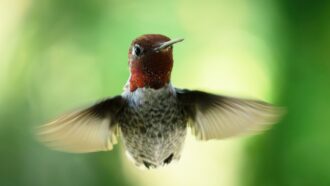
Maria Temming
Assistant Managing Editor, Science News Explores
Maria Temming is the Assistant Managing Editor at Science News Explores. Maria has undergraduate degrees in physics and English from Elon University and a master's degree in science writing from MIT. She has written for Scientific American, Sky & Telescope and NOVA Next. She’s also a former staff writer at Science News.

All Stories by Maria Temming
-
 Animals
AnimalsLet’s learn about orangutans
These shaggy, red-haired apes are more solitary than other primates, but moms and babies share a strong bond.
-
 Genetics
GeneticsScientists Say: Telomere
These protective caps at the ends of chromosomes play a key role in cell replication.
-
 Materials Science
Materials ScienceScientists Say: Goldene
Making this metallic, two-dimensional (2-D) material is difficult — but super-thin sheets of gold could have uses in electronics and chemistry.
-
 Animals
AnimalsScientists Say: Beakiation
Parrots use this clever sidestepping motion to maneuver along thin branches.
-
 Space
SpaceScientists Say: Astronomical interferometry
This technique links up many telescopes to see the universe in finer detail than any single telescope could alone.
-
 Animals
AnimalsScientists Say: Endotherm and Ectotherm
Endotherms use their own energy to maintain their internal temperature. Ectotherms use external heat sources to control their body temperature.
-
 Health & Medicine
Health & MedicineScientists Say: Menstruation
Menstruation is part of a roughly monthly cycle that helps a person’s body prepare for possible pregnancy.
-
 Space
SpaceScientists Say: Cosmic microwave background
The cosmic microwave background is the afterglow of the Big Bang.
-
 Animals
AnimalsSee how hummingbirds sneak through small spaces
Anna’s hummingbirds can use a couple of different techniques to get through gaps smaller than their wingspan.
-
 Plants
PlantsLet’s learn about photosynthesis
Thank photosynthesis for the existence of all complex life on Earth — including us.
-
 Animals
AnimalsScientists Say: Compound Eye
Compound eyes made up of many smaller visual structures may not produce crisp images, but they offer a great field of view.
-
 Physics
PhysicsLet’s learn about particles that help us peer inside objects
Particles such as muons, X-rays and neutrons help scientists peer inside fossils, mummies, pyramids, volcanoes and the human body.